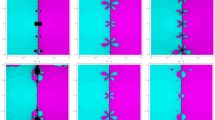Abstract
This paper provides newly implemented [11], [13] and widely applicable methods for, computing inclusion (i. e. a containing interval) (Einschließung) of the solution of a fixed point equationf(x)=x as well as autmatic verification the existence (Existenz) and uniqueness (Eindeutigkeit) of the solution. These methods make essential use of a new computer arithmetic defined by semimorphisms as developed in [7] and [8]. We call such methods E-Methods in correspondance to the three German words. A priori estimations such as a bound for a Lipschitz constant etc. are not required by the new algorithm. So the algorithm including the a posteriori proof of existence and uniqueness of the fixed point is programmable on computers for linear as well as for nonlinear problems. This is a key feature of our results. The computations produced by E-methods deliver answers the components of which have accuracy better than 10−t+1 (wheret denotes the mantissa length employed in the computer).
Zusammenfassung
Es werden neuartige sehr allgemeine Methoden vorgestellt, die sowohl eine Einschließung der Lösung von Fixpunktgleichungenf(x)=x als auch automatisch dieExistenz und gegebenenfallsEindeutigkeit der Lösung nachweisen. Diese Methoden machen wesentlichen Gebrauch von neuen Rechnerarithmetiken, die charakterisiert sind wie in [2], [7] und [8] entwickelt. Wir nennen solche Methoden E-Methoden in Übereinstimmung mit den drei Anfangsbuchstaben. A-priori-Abschätzungen wie z. B. für Schranken von Lipschitzkonstanten sind nicht mehr notwendig. Daher ist es in eleganter Weise möglich, Algorithmen zu implementieren, die einen automatischen Existenz- und Eindeutigkeitsnachweis für den Fixpunkt von linearen und nichtlinearen Fixpunktgleichungen ermöglichen. Die mit E-Methoden berechneten Lösungen haben i. a. eine relative Genauigkeit, die besser als 10−t+1 ist (wobeit die Mantissenlänge des verwendeten Rechners bezeichnet).
Similar content being viewed by others
References
Alefeld, G., Herzberger, J.: Einführung in die Intervallrechnung. Mannheim-Wien-Zürich: Bibliographisches Institut 1974.
Bohlender, G.: Floating-point computation of functions with maximum accuracy. IEEE Trans. on Computers1977, 621.
Hansen, E.: Interval arithmetic in matrix computations, Part I. SIAM J. Numer., Anal.2, 308–320 (1965).
Hansen, E., Smith, R.: Interval arithmetic in matrix computations. Part II. SIAM J. Numer. Anal.4, 1–9 (1967).
Kaucher, E., Rump, S. M.: Generalized iteration methods for bounds of the solution of fixed operator equations. Computing24, 131–137 (1980_.
Krawczyk, R.: Newton-Algorithmen zur Bestimmung von Nullstellen mit Fehlerschranken. Computing4, 187–201 (1969).
Kulisch, U.: Grundlagen des numerischen Rechnens (Reihe Informatik, 19). Mannheim-Wien-Zürich: Bibliographisches Institut 1976.
Kulisch, U., Miranker, W. L.: Computer arithmetic in theory and practice. Academic Press 1981.
Moore, R. E.: A test for existence of solutions for nonlinear systems. SIAM J. Numer. Analysis4 (1977).
Rump, S. M., Kaucher, E.: Small bounds for the solution of systems of linear equations, in: Computing, Suppl. 1. Wien-New York: Springer 1978.
Rump, S. M.: Kleine Fehlerschranken bei Matrixproblemen. Dissertation, Universität Karlsruhe, 1980.
Wongwises, P.: Experimentelle Untersuchungen zur numerischen Auflösung von linearen Gleichungssystemen mit Fehlererfassung. Interner Bericht 75/1, Institut für Praktische Mathematik, Universität Karlsruhe.
Kulisch, U., Wippermann, H.-W.: PASCAL-SC, PASCAL für wissenschaftliches Rechnen, Gemeinschaftsentwicklung von Institut für Angewandte Mathematik, Universität Karlsruhe (Prof. Dr. U. Kulisch), Fachbereich Informatik, Universität Kaiserslautern (Prof. Dr. H.-W. Wippermann).
Author information
Authors and Affiliations
Rights and permissions
About this article
Cite this article
Kaucher, E., Rump, S.M. E-methods for fixed point equations f(x)=x. Computing 28, 31–42 (1982). https://doi.org/10.1007/BF02237993
Received:
Revised:
Issue Date:
DOI: https://doi.org/10.1007/BF02237993



